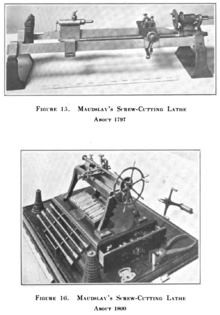செந்தரமாக்கம்
செந்தரமாக்கம் (Standardization) அல்லது standardisation தொழில்நுட்பச் செந்தரங்களை உருவாக்கி நடைமுறைப்படுத்தும் நிகழ்வாகும். இது நிறுமங்கள், பயனர்கள், ஆர்வக் குழுக்கள், செந்தர நிறுவனங்கள், அரசு அமைப்புகள் என பல தரப்பட்டாரின் பொதுக் கருத்திசைவைச் சார்ந்து உருவாகிறது.[1] செந்தரமாக்கம் பொருத்தப்பாடு, தரம், மீள்பயன்திறம், காப்புறுதி, இடைவினைத்திறம் ஆகியவற்றைப் பெரும மாக்குகிறது. இது வழக்கமாக நடக்கும் நிகழ்வுகள் தொடர்ந்து தானே அமையவைக்கிறது. பொருளியல் உட்பட்ட சமூக அறிவியல் புலங்களில்,[2] செந்தரமாக்க எண்ணக்கரு ஒருங்கிணைப்புச் சிக்கலுக்கான தீர்வாக அமைகிறது இச்சூழலில் பங்குகொள்ளும் அனைத்துத் தரப்பினரும் தம் அனைவருக்கும் இசைவாக முடிவுகளையெடுத்து சம ஈட்டம் அல்லது இலாபம் அடிகின்றனர், இந்தக் கண்ணோட்டம் "தன்னியல்பான செந்தரமாக்க நிகழ்வுகளையும்" உள்ளடக்கும். இது இயல்பாகவே செந்தரங்களை உருவாக்குகிறது.
வரலாறு
[தொகு]மிக முந்திய எடுத்துகாட்டுகள்
[தொகு]சிந்துவெளி நாகரிகம் செந்தர எடைகளையும் அளவுகளையும் உருவாக்கிப் பயன்படுத்தியது.[3] மையப்படுத்திய எடைகளும் அளவுகளும் சிந்துவெளி வணிகருக்கு வணிகத்தை எளிமையாக்கியுள்ளது. சிறிய எடைகள் ஆடம்பர நுண்பொருள்களை நிறுக்கவும் பெரிய எடைகள் உணவு போன்ற பேரளவு பொருட்களை நிறுக்கவும் பயன்பட்டுள்ளன.[4] எடைகள் செந்தர அலகு எடையின் மடங்குகளில் வகைபடுத்தப்பட்டுள்ளன.[4] கட்டுமானத் தொழில்நுட்பச் செந்தரங்கள் அளவைக் கருவிகளிலும் முறைகளிலும் பயன்பட்டுள்ளன.கட்டுமான அளவுகளும் கோண அளவுகளும் துல்லியமாகப் பயன்படுத்தப்பட்டுள்ளன.[5] உலோத்தல், சுர்கோட்ட்டா, காளிபங்கன், தோலவீரா அரப்பா, மொகஞ்சதோரா ஆகிய ந்கரங்களைத் திட்டமிட்டு அமைப்பதில் நீள அளவுகளுக்கான சீரான அலகுகள் பயன்பாட்டில் இருந்துள்ளன.[3] சிந்துவெள் அளவுகளும் எடைகளும் பாரசீகத்துக்கும் நடுவண் ஆசியாவுக்கும் பரவியுள்ளன; அங்கே அவை களத்துக்கு ஏற்ப மாற்றப்பட்டுள்ளன.[6] சிகியோ இவாட்டா பின்வருமாறு சிந்துவெளி அகழாய்வில் எடுக்கப்பட்ட எடைகள் பற்றிக் கூறுகிறார்:
மொகஞ்சதாரோ, அரப்பா, சாங்குதாரோ நகரங்களில் 558 எடைக்கற்கள் கிடைத்துள்ளன; அவற்றில் ஒன்றுகூட கறைபாட்டுடன் அமையவில்லை. ஐந்து வேறுபட்ட அடுக்குகளில் கிடைத்த எடைகளில் வேறுபாடேதும் இல்லை. ஒவ்வொரு அடுக்குக்குமிடையில் 1.5மீ ஆழ வேறுபாடு அமைந்திருந்தது. எனவே, இது 500 ஆண்டு கால இடைவெளி வரை சீரான கட்டுபாடு நிலவியதைக் காட்டுகிறது. சிந்து சமவெளி எடையின் அலகு 13.7 கிராம் ஆக இருந்தமை அறியப்பட்டுள்ளது சிந்துவெளி எண்குறிமுறைகளில் இருமான, பதின்மான எண்முறைகள் இரண்டுமே பயன்பட்டுள்ளன. மேற்குற்ப்பிட்ட மூன்று நகரங்களிலும் கிடைத்த எடைகளில் 83% பருஞ்சதுர வடிவத்தில் உள்ளன அவற்றில் 68% எடைகள் செர்ட்டினால் ஆனவை.[3]
18 ஆம் நூற்றாண்டு முயற்சிகள்
[தொகு]
தொழிற்புரட்சிக்குப் பின் தொழிலகத்திலும் வணிகத்திலும் செந்தரங்களை நடைமுறைப்படுத்த வேண்டிய தேவை ஏற்பட்டது. குறிப்பாக உயர்துல்லிய எந்திர உளிகளும் இடைமாற்றவல்ல எந்திரப் பாகங்களும் இன்றியமையாதன ஆகின.
என்றி மவுத்சுலே 1990 இல் முதல் தொழிலக நடைமுறைக்கேற்ற திருகு வெட்டும் கடைசல் எந்திரத்தை உருவாக்கினார். இது முதன்முதலாக திருகு மரையளவுகள் செந்தரமாக உதவியது. எனவே, நடைமுறையில் இடைமாற்றவல்ல பாகங்கள் உருவாக வழிவகுத்தது (இந்த எண்ணக்கரு முன்னமே மரைகளுக்கும் மரையாணிகளுக்கும் உருவாகத் தொடங்கி இருந்தது.[7]
இதற்கு முன்பு திருகுப் புரிகள் செதுக்கியும் அராவியும் செய்யப்பட்டன ( இப்பணி திறமை மிகுந்த பணியாளர்களின் கைகளால் செய்யப்பட்டது). அப்போது மரைகளே இல்லை அல்லது அருகியே இருந்துள்ளன; பொன்மத் திருகுகள் செய்யப்பட்டால் அவை மரவேலைகளிலேயே பயன்பட்டன. பொன்ம மரையாணிகள் மரச்சட்டத்தில் ஊடுருவி அடுத்தப் பக்கத்தில் அமைந்த இணைப்பிகள் அல்லது கோர்ப்பிகள் மரையில்லாத முறிகளிலேயே இணைக்கப்பட்டன ( இது தட்டியோ அல்லது அடைவலயம் செருகியோ மேற்கொள்ளப்படும்). மவுத்சுலே திருகுப் புரிகளைச் செந்தரப்படுத்தினார். மேலும், அவர் தன் பணிப்பட்டறையில் அச்செந்தரங்களின்படி பொருந்தும் மரைகளையும் மறையாணிகளையும் செய்ய ஏற்ற உளிகளையும் அச்சுகளையும் உருவாக்கினார். எனவே குறிப்பிட்ட அளவு மரையாணி அதற்குரிய அதே அலவுள்ள மரையில் கச்சிதமாகப் பொருந்தியது. இது பணிப்பட்டறைத் தொழில்நுட்பத்தில் ஏற்பட்ட மாபெரும் முன்னேற்றமாக விளங்கியது.[8]
தேசியச் செந்தரம்
[தொகு]மேலும் படிக்க
[தொகு]- Dickson, E. W.; Singh, S.; Cheung, D. S.; Wyatt, C. C.; Nugent, A. S. (2008). "Application of Lean Manufacturing Techniques in the Emergency Department". Journal of Emergency Medicine 37 (2): 177–182. doi:10.1016/j.jemermed.2007.11.108. பப்மெட்:18722732.
- Langenberg, T. (2005). Standardization and Expectations. Berlin: Springer-Verlag. பன்னாட்டுத் தரப்புத்தக எண் 3-540-28112-6.
- Murphy, C. N.; Yates, J. (2008). The International Organization for Standardization (ISO) : Global Governance Through Voluntary Consensus. New York: Routledge. பன்னாட்டுத் தரப்புத்தக எண் 978-0-415-77429-1.
- Wenzlhuemer, Roland (2010). "The History of Standardisation in Europe". European History Online. http://nbn-resolving.de/urn:nbn:de:0159-20100921441.
மேற்கோள்கள்
[தொகு]- ↑ Xie, Zongjie; Hall, Jeremy; McCarthy, Ian P.; Skitmore, Martin; Shen, Liyin (2016-02-01). "Standardization efforts: The relationship between knowledge dimensions, search processes and innovation outcomes". Technovation. Innovation and Standardization 48–49: 69–78. doi:10.1016/j.technovation.2015.12.002.
- ↑ Blind, K. (2004). The economics of standards. Cheltenham: Edward Elgar. பன்னாட்டுத் தரப்புத்தக எண் 978-1-84376-793-0.
- ↑ 3.0 3.1 3.2 Iwata, Shigeo (2008), "Weights and Measures in the Indus Valley", Encyclopaedia of the History of Science, Technology, and Medicine in Non-Western Cultures (2nd edition) edited by Helaine Selin, pp. 2254–2255, Springer, பன்னாட்டுத் தரப்புத்தக எண் 978-1-4020-4559-2.
- ↑ 4.0 4.1 Kenoyer, Jonathan Mark (2006), "Indus Valley Civilization", Encyclopedia of India (vol. 2) edited by Stanley Wolpert, pp. 258–266, Thomson Gale, பன்னாட்டுத் தரப்புத்தக எண் 0-684-31351-0
- ↑ Baber, Zaheer (1996), The Science of Empire: Scientific Knowledge, Civilization, and Colonial Rule in India, State University of New York Press, பன்னாட்டுத் தரப்புத்தக எண் 0-7914-2919-9.
- ↑ In the third millennium BCE the Indus measuring system was further developed in the ancient regions of Iran and Afghanistan -- Iwata, 2254.
- ↑ Wang Ping (April 2011), A Brief History of Standards and Standardization Organizations: A Chinese Perspective (PDF), EAST-WEST CENTER WORKING PAPERS, archived from the original (PDF) on 2019-06-12, பார்க்கப்பட்ட நாள் 2019-12-14
- ↑ Rolt, L. T. C. (1962). Great Engineers. Bell and Sons.
வெளி இணைப்புகள்
[தொகு]- "Benefits of standards and standardization". COoperation Platform for Research And Standards (COPRAS project).
- "Which type of standards should my project pursue". COoperation Platform for Research And Standards (COPRAS project).
- "Why standards matter". ISO. Archived from the original on 2012-01-12. பார்க்கப்பட்ட நாள் 2019-12-11.
- "What standards do". ISO. Archived from the original on 2012-01-12. பார்க்கப்பட்ட நாள் 2019-12-11.
- "Who standards benefit". ISO.
- "Standards Myths". European Committee for Standardization (CEN). Archived from the original on 29 ஆகஸ்ட் 2009. பார்க்கப்பட்ட நாள் 8 July 2009.
((cite web)): Check date values in:|archive-date=(help)
Text is available under the CC BY-SA 4.0 license; additional terms may apply.
Images, videos and audio are available under their respective licenses.
